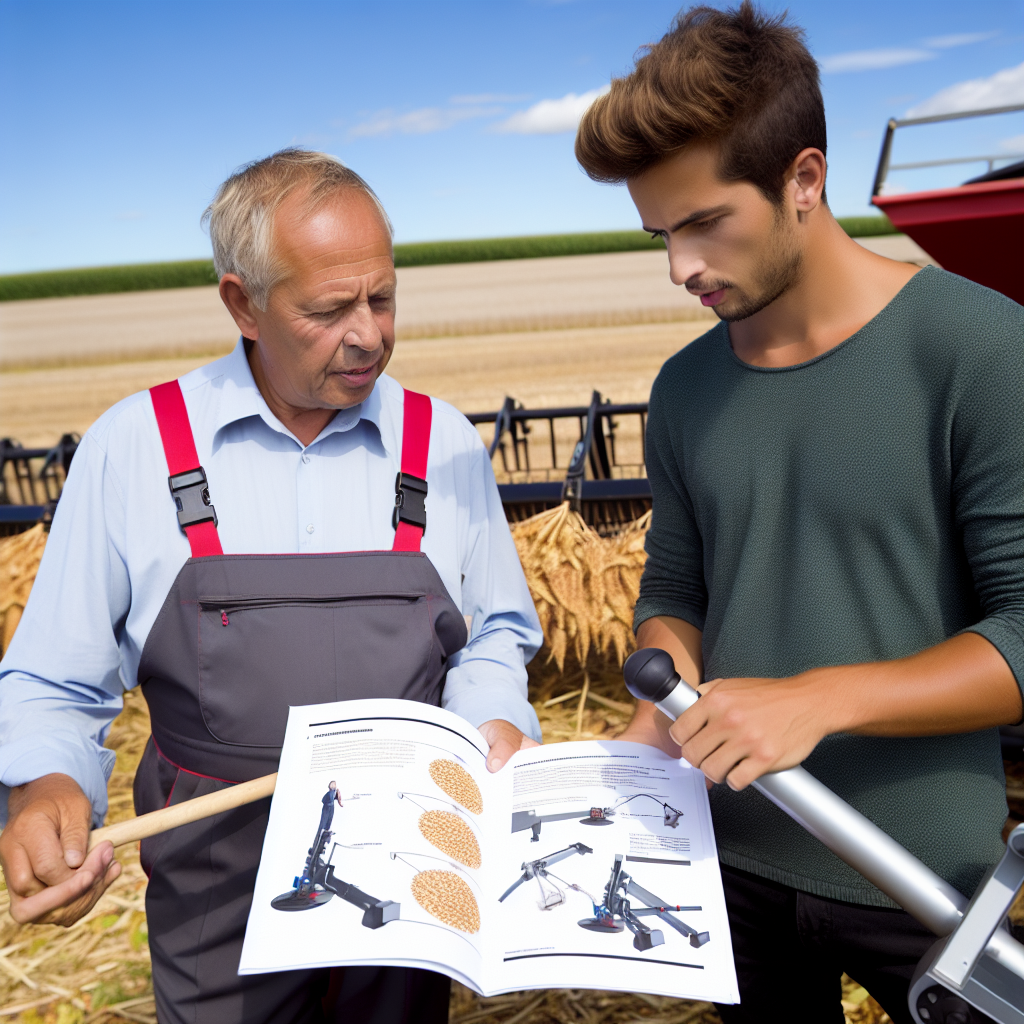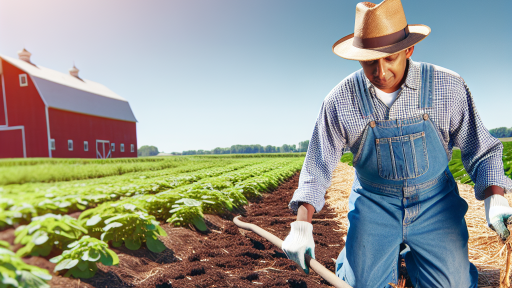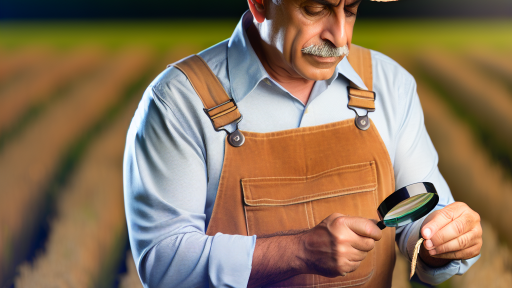Introduction to Post-Harvest Techniques and Their Importance
Post-harvest techniques play a crucial role in agriculture.
They significantly impact the quality and shelf life of produce.
Effective techniques reduce waste and maximize profit for farmers.
Moreover, they help maintain the nutritional value of foods.
The importance of post-harvest management cannot be overstated.
Globally, billions of dollars worth of crops are lost each year.
These losses occur due to improper handling, storage, and transportation.
By adopting effective post-harvest strategies, farmers can minimize these losses.
In addition, they can increase the availability of food resources.
Training farmers on these techniques is essential for food security.
A comprehensive understanding of post-harvest methods leads to better practices.
It also empowers farmers to make informed decisions.
Key Post-Harvest Techniques
Various techniques help ensure the effective handling of crops after harvest.
These include proper cleaning and sorting of produce.
Moreover, effective drying methods are vital for reducing moisture content.
Transform Your Agribusiness
Unlock your farm's potential with expert advice tailored to your needs. Get actionable steps that drive real results.
Get StartedEffective storage practices prevent spoilage and pest infestations.
Furthermore, appropriate packaging helps protect produce during transportation.
The Role of Training Programs
Training programs provide farmers with essential knowledge.
These programs cover various post-harvest methodologies.
Additionally, they emphasize the importance of hygiene and safe practices.
Such training facilitates the adoption of modern technologies.
Farmers can implement sustainable practices in their operations.
Moreover, they gain access to resources and better market opportunities.
Common Challenges Farmers Face After Harvesting
Post-Harvest Losses
Farmers often struggle with post-harvest losses due to improper handling.
This issue arises from poor storage practices and inadequate transportation.
Many crops are highly perishable and require immediate attention.
Without efficient methods, significant quantities of produce can spoil.
Farmers need to adopt effective techniques to reduce these losses.
Pest Infestations
After harvest, crops often become vulnerable to pests.
Insects and rodents can damage stored produce quickly.
Many farmers lack knowledge about appropriate pest control methods.
Effective pest management is crucial for maintaining quality.
Farmers should implement preventive strategies to reduce infestations.
Quality Control Issues
Maintaining the quality of harvested crops can be challenging.
Environmental factors like humidity and temperature affect quality.
Many farmers are unaware of proper quality control measures.
Regular monitoring and assessment are essential during storage.
Implementing standardized practices can enhance product value.
Market Access Difficulties
Farmers often struggle to access local and international markets.
Showcase Your Farming Business
Publish your professional farming services profile on our blog for a one-time fee of $200 and reach a dedicated audience of farmers and agribusiness owners.
Publish Your ProfileA lack of knowledge about market demand can hinder sales.
Effective communication with buyers is crucial for success.
Farmers should explore various marketing channels to reach customers.
Building relationships with local vendors can improve market access.
Financial Constraints
Limited financial resources often restrict farmers’ post-harvest activities.
Investment in proper equipment can lead to better efficiency.
Many farmers lack access to credit or financial support.
Seeking grants and loans can help mitigate these financial challenges.
Planning budgets effectively is key to sustaining operations.
Overview of Key Post-Harvest Techniques
Importance of Post-Harvest Techniques
Post-harvest techniques significantly reduce food losses.
They improve the quality of agricultural products.
Additionally, these methods enhance shelf life and market value.
Farmers benefit economically from implementing effective practices.
Sorting and Grading
Sorting ensures that only high-quality products reach the market.
Farmers should separate produce based on size and quality.
This improves presentation and consumer appeal.
Grading helps set fair prices and meet customer expectations.
Drying Techniques
Drying removes moisture from crops, preventing spoilage.
Farmers can use solar drying, a cost-effective method.
Mechanical dryers offer faster results for larger operations.
Proper drying techniques enhance the storability of grains.
Storage Solutions
Efficient storage minimizes post-harvest losses.
Farmers should use airtight containers to prevent pest infestation.
Temperature control in storage areas extends product life.
Regular monitoring of stored goods ensures quality maintenance.
Transportation Methods
Safe transportation protects products during delivery.
Farmers must use appropriate vehicles to minimize damage.
Proper packaging can prevent bruising and spoilage.
Planning routes can optimize time and reduce costs.
Marketing Strategies
Effective marketing increases product visibility in the market.
Farmers should explore both online and offline channels.
Building relationships with local buyers enhances sales opportunities.
Promotions can attract more customers to their produce.
See Related Content: IoT Sensors Transforming Crop Analytics Today
Training Methods for Farmers
Workshops
Workshops offer hands-on experience for farmers.
Farmers learn about post-harvest techniques in a collaborative environment.
These gatherings encourage discussions among participants.
Experts provide insights and personalize advice for farmers.
Workshops often include demonstrations for practical learning.
Participants can ask questions during these sessions.
Showcase Your Farming Business
Publish your professional farming services profile on our blog for a one-time fee of $200 and reach a dedicated audience of farmers and agribusiness owners.
Publish Your ProfileThis method promotes community engagement within farming.
Field Demonstrations
Field demonstrations showcase effective post-harvest techniques in real-time.
Farmers observe practices directly in the field.
These events highlight the benefits of improved methods.
Real-life examples make it easier for farmers to understand.
Field demonstrations promote a hands-on approach to learning.
Farmers can ask experts for personalized tips during these sessions.
Furthermore, these events facilitate networking among farmers.
Online Courses
Online courses provide flexibility for farmers with busy schedules.
Farmers can access resources at their own pace.
These courses often include videos and interactive modules.
Farmers can participate in discussions with experts and peers.
Additionally, online courses reach a wider audience.
This method accommodates diverse learning styles and preferences.
Online training expands access to quality education for all farmers.
See Related Content: Aquaponics Water Management Tips
Importance of Proper Storage and Handling
Understanding the Need for Effective Techniques
Proper storage and handling of crops significantly influences quality and longevity.
Farmers who employ effective techniques can reduce post-harvest losses.
Additionally, these methods enhance product marketability and profitability.
Thus, strong knowledge in this area is essential for sustainable agricultural practices.
Methods for Effective Storage
Various storage methods cater to specific crops and conditions.
Farmers should understand the best techniques to ensure optimal preservation.
Common methods include airtight containers, refrigeration, and controlled atmospheres.
Each method offers distinct advantages depending on the crop being stored.
Airtight Containers
Airtight containers prevent moisture and pest infestation.
Farmers can use such containers for grains and dry produce.
Moreover, these setups maintain freshness and prolong shelf life.
Refrigeration
Refrigeration is vital for perishable crops like fruits and vegetables.
This method helps retain flavor, texture, and nutritional value.
Farmers should monitor temperatures closely for effectiveness.
Controlled Atmospheres
This advanced method adjusts oxygen and carbon dioxide levels in storage.
Controlled atmospheres can significantly extend the life of certain crops.
These systems require an understanding of specific crop needs.
Best Practices in Handling
Handling techniques play a critical role in maintaining crop integrity.
Farmers should practice care during harvesting, packing, and transporting.
Gentle handling reduces bruising and damage to delicate items.
Training individuals in proper techniques enhances overall outcomes.
Harvesting with Care
Using suitable tools minimizes damage while harvesting.
Farmers must be cautious not to overexert themselves, risking injury to crops.
They should work during cooler parts of the day to reduce heat stress.
Showcase Your Farming Business
Publish your professional farming services profile on our blog for a one-time fee of $200 and reach a dedicated audience of farmers and agribusiness owners.
Publish Your ProfileSafe Packing Methods
Pack crops in sturdy containers that allow airflow.
Ensure materials are clean and free from contaminants.
Label containers clearly to keep track of produce type and storage dates.
Effective Transportation Techniques
Transportation methods must shield crops from extreme temperatures.
Farmers should choose vehicles equipped for temperature regulation.
Additionally, secure loads properly to prevent shifting and damage.
Find Out More: Cover Crops: Enhancing Biodiversity on Your Farm
Quality Control Measures: Sorting, Grading, and Packaging
Importance of Quality Control
Quality control plays a crucial role in the agricultural sector.
It ensures that produce meets market standards.
Moreover, it helps maintain customer satisfaction.
Effective quality control reduces waste and loss.
Sorting Techniques
Sorting is the first step in quality control.
This process involves separating produce based on size, color, and quality.
Farmers should use well-defined categories for sorting.
For instance, use specific sizes for fruits and vegetables.
Visual inspection aids in identifying defective products.
Investing in sorting equipment improves efficiency.
Grading Standards
Grading establishes quality benchmarks for products.
Farmers must understand relevant grading systems.
For example, USDA grading can influence market value.
Educating farmers on these standards is essential.
Graded products often command higher prices.
Types of Grading Systems
Different grading systems exist for various crops.
Horticultural crops often follow visual grading.
Grain crops typically rely on weight and moisture measurements.
Farmers should become familiar with these grading systems.
Packaging Best Practices
Proper packaging protects produce during transportation.
It also preserves freshness and quality.
Farmers should select appropriate materials for packaging.
Plastic crates can be a durable option for many crops.
Labeling packages is vital for traceability.
Sustainable Packaging Options
Choosing sustainable packaging reduces environmental impact.
Biodegradable materials are increasingly popular.
Farmers can explore reusable packaging solutions.
Innovative packaging attracts environmentally conscious consumers.
Regular Training and Education
Training sessions help farmers stay updated on best practices.
Workshops can focus on new techniques and technologies.
Networking with agricultural experts provides valuable insights.
Continuous education ensures long-term success in farming.
See Related Content: Advanced Tools For Pest And Disease Forecasting
Showcase Your Farming Business
Publish your professional farming services profile on our blog for a one-time fee of $200 and reach a dedicated audience of farmers and agribusiness owners.
Publish Your Profile
Strategies for Reducing Post-Harvest Losses
Understanding Post-Harvest Losses
Post-harvest losses significantly affect food security worldwide.
Farmers often face challenges in storage and transportation.
These losses can occur at various stages of the supply chain.
Innovative Solutions for Storage
Effective storage is critical to minimizing losses.
Farmers can utilize improved storage facilities.
For instance, hermetic bags prevent moisture and pests.
Ventilated storage structures help maintain product quality.
Moreover, insulated storage can reduce temperature fluctuations.
Transportation Techniques
Safe transportation is essential for fresh produce.
Farmers should use appropriate containers to reduce damage.
Temperature control during transport preserves freshness.
Employing local markets can shorten travel distances.
This practice ultimately minimizes losses during transit.
Utilizing Technology
Technology plays a vital role in post-harvest management.
Mobile apps can aid farmers in tracking conditions.
Remote sensing technology assists in monitoring crops.
Data analytics can optimize harvesting schedules efficiently.
Furthermore, innovative packaging extends shelf life.
Education and Training Programs
Education is vital in reducing post-harvest losses.
Training programs inform farmers about best practices.
Workshops on proper handling techniques enhance skills.
Moreover, peer-to-peer learning fosters community support.
Collaboration with agricultural experts further enriches knowledge.
Government and NGO Support
Governments play a crucial role in supporting farmers.
Subsidies can help farmers invest in better storage solutions.
NGOs can provide resources and educational materials.
Partnerships between farmers and organizations strengthen efforts.
Ultimately, combined efforts lead to reduced losses.
Case Studies: Successful Implementation of Post-Harvest Techniques in Various Farming Communities
Enhancing Grain Storage Methods
In the rural community of Mbale, farmers faced severe losses due to grain spoilage.
To mitigate this, the local agricultural extension service provided training on improved storage techniques.
Farmers learned to use airtight containers, significantly reducing exposure to pests and humidity.
As a result, the community reported a 30% increase in grain longevity.
Moreover, these methods improved food security for many families.
Utilizing Solar Drying Facilities
In the coastal region of Mombasa, fishermen struggled with preserving their catch.
A cooperative introduced solar drying as an effective post-harvest method.
Farmers attended workshops demonstrating the benefits of solar drying technology.
The new approach increased product shelf-life and marketability.
Consequently, fishermen experienced a boost in their income due to higher-quality dried fish.
Implementing Organic Waste Recycling
In the town of Limuru, farmers faced challenges with excess crop residues.
To address this issue, a local NGO launched a training program on organic waste recycling.
Showcase Your Farming Business
Publish your professional farming services profile on our blog for a one-time fee of $200 and reach a dedicated audience of farmers and agribusiness owners.
Publish Your ProfileFarmers learned to convert crop residues into compost, enriching their soil health.
This sustainable practice not only reduced waste but also improved crop yields.
As a result, many farmers switched to organic practices, enhancing their market competitiveness.
Introducing Efficient Pack House Operations
In the fertile valleys of Nyeri, smallholder farmers sought to increase their produce’s market value.
A team of agronomists introduced efficient pack house operations to the area.
Training sessions covered sorting, packing, and grading techniques tailored for high-demand markets.
Farmers quickly adopted these methods, enhancing the quality of packaged produce.
Ultimately, their sales improved, leading to better livelihoods for many households.
Evaluating the Impact of Training Programs on Farm Productivity and Profitability
Introduction to Training Programs
Training programs equip farmers with essential post-harvest techniques.
These techniques improve the quality of harvested products.
Farmers gain skills that directly enhance profitability.
Current Challenges in Post-Harvest Management
Farmers face numerous challenges in post-harvest management.
Improper handling often leads to significant losses.
Additionally, a lack of knowledge hampers productivity.
Thus, there is a need for effective training solutions.
Objectives of Training Programs
The primary goal is to reduce post-harvest losses.
Furthermore, participants learn about proper storage practices.
They also gain insights into market trends and demand.
Ultimately, these programs aim to boost overall farm income.
Measuring Impact on Productivity
Evaluating the effectiveness of training programs is crucial.
Farm productivity shows marked improvement post-training.
Farmers report increased crop quality and quantity.
Additionally, they adopt better techniques learned in training.
Financial Outcomes of Enhanced Techniques
Increased productivity translates to higher profitability.
Farmers notice a reduction in costs related to spoilage.
Moreover, they enjoy better prices for quality products.
Overall, effective post-harvest techniques lead to a sustainable income.
Case Studies Illustrating Success
Several success stories highlight the program’s impact.
For example, Maria, a cacao farmer, doubled her income.
Similarly, the Greenfield Farming Cooperative reported reduced losses by 40%.
These examples demonstrate the real-world benefits of training.
Future Directions and Recommendations
Continuing to refine training programs will enhance effectiveness.
Incorporating technology can improve learning experiences.
Furthermore, establishing partnerships with local organizations is vital.
Through these efforts, we can optimize training outcomes.
Future Trends in Post-Harvest Management and Farmer Training
Adoption of Technology
Farmers increasingly utilize technology for post-harvest management.
Mobile applications streamline communication and information sharing.
Drones now monitor crop health and harvest readiness.
Data analytics enhance decision-making processes effectively.
Moreover, automation reduces labor costs and improves efficiency.
Showcase Your Farming Business
Publish your professional farming services profile on our blog for a one-time fee of $200 and reach a dedicated audience of farmers and agribusiness owners.
Publish Your ProfileFocus on Sustainability
Sustainability is becoming a central theme in agricultural practices.
Post-harvest techniques increasingly emphasize reducing waste.
Farmers adopt eco-friendly packaging to minimize environmental impact.
Additionally, organic materials for storage and transport gain popularity.
These methods not only benefit farmers but also protect our planet.
Increased Training Opportunities
Training programs are evolving to meet new challenges in agriculture.
Workshops now include practical demonstrations and hands-on training.
Farmers gain access to online resources and virtual classrooms.
Networking events foster collaboration among farmers and experts.
Consequently, continuous education becomes essential for success.
Consumer Awareness and Demand
Consumers become more conscious of food quality and safety.
This awareness drives demand for better post-harvest practices.
Farmers respond by adopting traceability systems for their products.
Transparency in food production increases consumer trust.
As a result, better post-harvest practices lead to higher market value.
Integration of Climate Adaptation Techniques
Farmers are learning climate adaptation techniques for better resilience.
Post-harvest techniques now include strategies for varying weather conditions.
This integration helps minimize losses during storage and transport.
For instance, proper ventilation can protect against humidity fluctuations.
Thus, farmers become more equipped to handle climate uncertainties.
Additional Resources
Post-harvest food losses in a maize-based farming system of semi …




